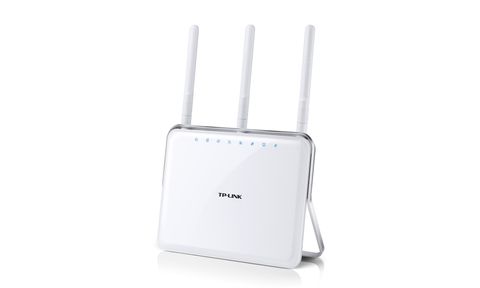IT Pro Verdict
If you need an ADSL router with good, though not spectacular, wireless performance and would find the ability to - slowly - share USB storage devices or printers with other systems around the house, the TP-Link Archer D9 is a solid choice. There are cheaper options, however.
Pros
- +
Fast wireless connectivity; small footprint; USB ports are a bonus.
Cons
- -
File sharing performance is slow; media sharing is buggy; illegal Wi-Fi defaults; TP-Link's user interface could do with an overhaul.
The Archer D9 is designed to sit at the very top of TP-Link's router range, alongside the C9 variant designed for cable broadband connections. The design immediately stands out from the company's usual fare: rather than a black box which sits flat on your desktop, the Archer D9 and C9 both stand upright through a plastic stand at the rear.
The result is a far smaller footprint than the company's previous releases, at the cost of height - and measuring 33.6cm by 24.2cm before the three detachable antennas are taken into account, the Archer D9 is certainly no waif.
Given its flat design, it's a shame that there's no alternative mounting option for the Archer D9. The plastic stand is fixed and immovable while the Ethernet and modem cables exit at a 90-degree angle. The result is a design which looks like it would fit well on a wall, but in reality will only ever be placed on a desk or a shelf.
This aside, the design is solid. The front is a solid piece of white plastic featuring integrated blue status LEDs and the TP-Link logo, but appears prone to cracking: despite arriving in an entirely intact retail shipping box, our sample had already developed a small crack along its bottom edge. Three large and solid-feeling antennas are provided, connecting to RP-SMA connectors along the top edge of the router.
As you might expect from a top-tier router, the Archer D9 boasts most of the latest standards: the Wi-Fi radio supports simultaneous operation in the 802.11b/g/n 2.4GHz and 802.11a/n/ac 5GHz bands, with the latter boasting support for a theoretical peak throughput of 1,900Mb/s. Four gigabit Ethernet ports are included, along with two USB ports - one USB 3.0 at the rear and one USB 2.0 at the side - for storage or printer sharing. Sadly, though, the modem is limited to ADSL2+ compatibility; those on VDSL connections who want to use the Archer D9 will need to set it to Ethernet routing mode and lose one of the four gigabit ports for connection to an external modem.

Gareth Halfacree is an experienced tech journalist and IT professional, and has been writing since 2006. In addition to contributing article for ITPro, Gareth has been featured in publications such as PC Pro, Techmeme, The Register, The MagPi, and Tom’s Hardware.
In addition to his digital articles, Gareth is the author of several best-selling books. These include the Raspberry Pi User Guide, an essential text for those looking to get started with their Raspberry Pi, as well as The Official Raspberry Pi Beginner’s Guide. Gareth also wrote the Official BBC micro:bit User Guide, a comprehensive guide to setting up the pocket-sized computer, learning to code on it, and even creating your own hardware addons.


